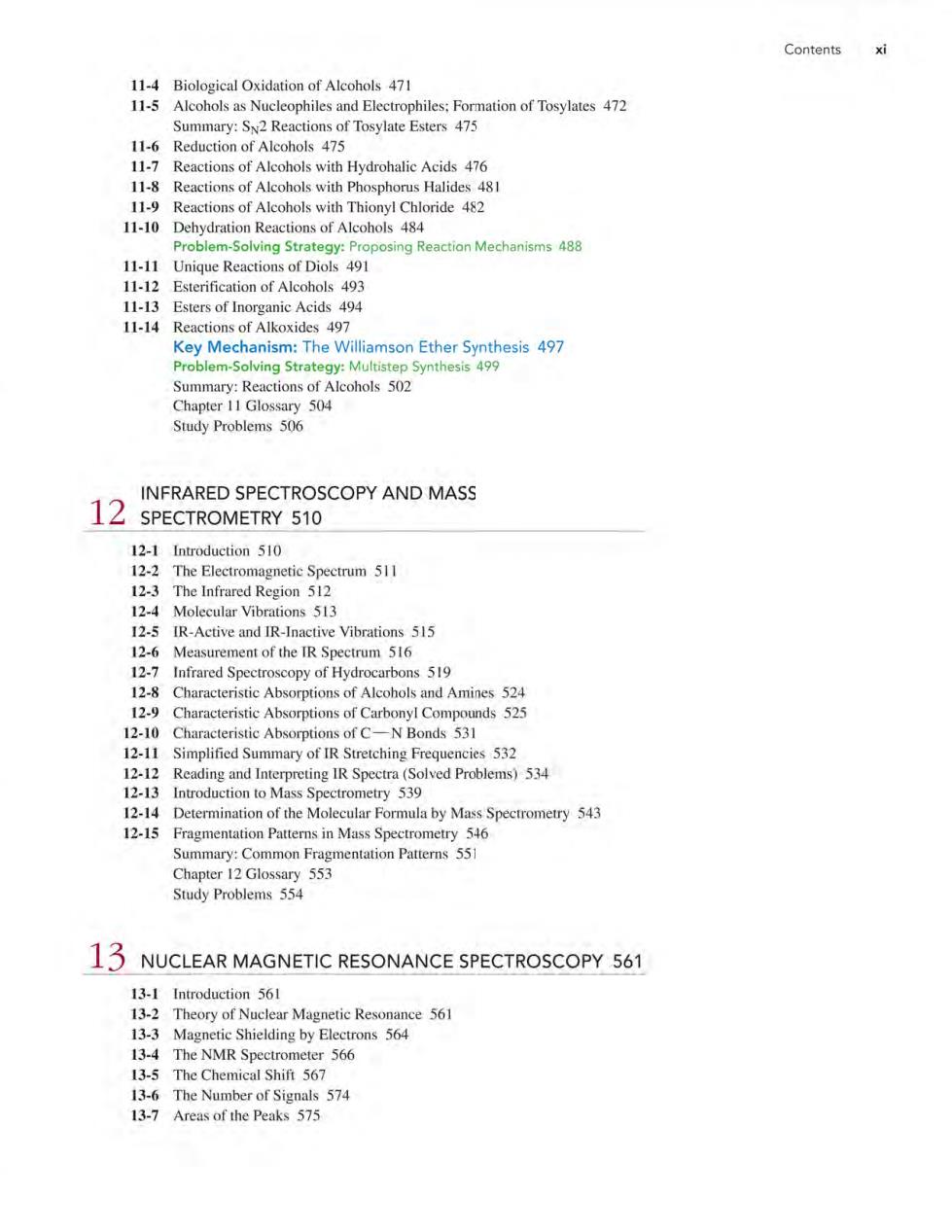正在加载图片...

Contents xi 11-4 Biological Oxidation of Alcohols 471 11-5 Alcohols as Nucleophiles and Electrophiles:Formation of Tosylates 472 Summary:S.2 Reactions of Tosylate Esters 475 11-6 Reduction of Alcohols 475 11-7 Reactions of Alcohols with Hydrohalic Acids 476 11-8 Reactions of Alcohols with Phosphorus Halides 48 11-9 Reactions of Alcohols with Thionyl Chloride 482 11-10 Dehydration Reactions of Alcohols 484 oposing Reaction Mechanisms 488 iomofAeohois49g 13 ers of In nic Acids 494 11-14 40 Mechanism:The Williamson Ether Synthesis 497 Problem-Solving Strategy:Multiste p Synthesis 499 Summary:Reactions of Alcohols 502 Chapter II Glossary 504 Study Problems 506 INERARED SPECTROSCOPY AND MASS 12 SPECTROMETRY 510 Introduction 510 ctrum5 125 -Active and R Vibrations 515 trum 516 138 ols and amines 524 risti Absortions of Carbonyl Com ounds 525 12-10 Charaeteristic Absomtions ofC-N Bonds 531 12-11 Simplified Summary of IR Stretching Frequencies 532 12-12 Reading and Interpreting IR Spectra(Solved Problems)534 12-13 Introduction to Mass Spectrometry 539 12-14 Determination of the Molecular Formula by Mas B5” 13 NUCLEAR MAGNETIC RESONANCE SPECTROSCOPY 561 13-1 Introduction 561 13-2 Theory of Nuclear Magnetic Resonance 561 13-3 Magnetic Shielding by Electrons 564 13-4 The NMR Spectrometer 566 13-5 The Chemical Shift 567 The Number of Signals 574 Areas of the Peaks 57511-4 Biological Oxidation of Alcohols 471 11-5 Alcohols as Nucleophiles and Electrophiles; Formation of Tosylates 472 Summary: SN2 Reactions of Tosylate Esters 475 11-6 Reduction of Alcohols 475 11-7 Reactions of Alcohols with Hydrohalic Acids 476 11-8 Reactions of Alcohols with Phosphorus Halides 481 11-9 Reactions of Alcohols with Thionyl Chloride 482 11-10 Dehydration Reactions of Alcohols 484 Problem-Solving Strategy: Proposing Reaction Mechanisms 488 11-11 Unique Reactions ofDiols 491 11-12 Esterification of Alcohols 493 11-13 Esters oflnorganic Acids 494 11-14 Reactions of Alkoxides 497 Key Mechanism: The Williamson Ether Synthesis 497 Problem-Solving Strategy: Multistep Synthesis 499 Summary: Reactions of Alcohols 502 Chapter 11 Glossary 504 Study Problems 506 INFRARED SPECTROSCOPY AND MASS 12 SPECTROMETRY 510 12-1 Introduction 510 12-2 The Electromagnetic Spectrum 511 12-3 The Infrared Region 512 12-4 Molecular Vibrations 513 12-5 IR-Active and IR-Inactive Vibrations 515 12-6 Measurement of the IR Spectrum 516 12-7 Infrared Spectroscopy of Hydrocarbons 519 12-8 Characteristic Absorptions of Alcohols and Amines 524 12-9 Characteristic Absorptions of Carbonyl Compounds 525 12-10 Characteristic Absorptions of C-N Bonds 531 12-11 Simplified Summary ofiR Stretching Frequencies 532 12-12 Reading and Interpreting IR Spectra (Solved Problems) 534 12-13 Introduction to Mass Spectrometry 539 12-14 Determination of the Molecular Formula by Mass Spectrometry 543 12-15 Fragmentation Patterns in Mass Spectrometry 546 Summary: Common Fragmentation Patterns 551 Chapter 12 Glossary 553 Study Problems 554 13 NUCLEAR MAGNETIC RESONANCE SPECTROSCOPY 561 13-1 Introduction 561 13-2 Theory of Nuclear Magnetic Resonance 561 13-3 Magnetic Shielding by Electrons 564 13-4 The NMR Spectrometer 566 13-5 The Chemical Shift 567 13-6 The Number of Signals 574 13-7 Areas of the Peaks 575 Contents xi